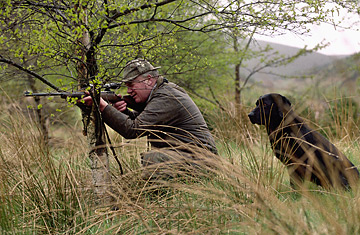
A hunter takes aim at his prey.
The latest assault aims to protect the thousands of birds, wildlife and even some endangered species that wildlife experts and activists claim die annually from ingesting spent ammo that gets left in the mountains, prairies, and forests where the hunted species thrive. As an alternative, "get-the-lead-out" advocates want hunters to start using copper, bismuth, tungsten, steel, tin, and other alloys in their bullets.
Some environmentalists claim they're also saving hunters from poisoning themselves and others when they eat their lead-filled kills, and they are hoping to make the ban nationwide, just as Canada did in 1999.
In 1991, the federal Fish and Wildlife Service banned lead ammo in waterfowl hunting — that of ducks and other birds that live on water — which, according to a FWS spokesperson, led to an estimated 64% reduction of lead poisoning in ducks on certain parts of the Mississippi. The most recent comprehensive state ban began on March 1 in Missouri, where state officials realized lead buckshot was harming populations of mourning doves, turkeys, quail, shorebirds and raptors. Several other states, including Washington, Arizona, Texas, Ilinois and Virginia, are also considering lead bans.
Hunting is not the only sporting activity that's going unleaded: in 2004, the Adirondack Cooperative Loon Program successfully lobbied New York State to ban the sale of small lead fishing weights after studies showed ducks, loons, and other waterfowl were mistakenly filling their gizzards with lethal lead sinkers. Other anti-lead fishing regulations are also in place in Maine, Massachusetts, New Hampshire, and Vermont.
In California, the stakes are more specific, and considerably higher. There, according to Paul Andreano of the "unleaded sportsman" organization Project Gutpile and other wildlife experts, lead has caused the death of 13 California condors. Thirteen may not sound like a large number, but it is for an endangered species whose population was down to a mere 22 in the 1980s and now, after two decades of capturing and breeding, still only hovers at 279 individual birds. According to a recent U.C.-Santa Cruz study, about one-third of 18 tested birds — easy victims because they are strictly scavengers and therefore chow often on lead-laden carcasses and gutpiles left over by hunters — had high levels of lead in their blood. Lead, says Andreano, is perhaps the primary barrier to the species' recovery.
The Center for Biological Diversity recently sued the state, prompting the California Department of Fish and Game to recommend to their decision-making commission that lead should be banned in the condor's massive flying range, which extends from roughly the San Francisco Bay Area south to Los Angeles. The commission will likely vote on the decision this summer, but a large swath of that land is already protected: in February, the state's largest private landholding — the 270,000-acre Tejon Ranch, where numerous condors can be found — banned hunting with lead shot. Not surprisingly, according to a survey completed last month by the National Shooting Sports Foundation, two-thirds of California hunters oppose the proposed state ban.
Environmentalists may not stop there. Says the Center's Jeff Miller, who notes that bald and golden eagles are also being poisoned: "The last major existence of lead in our environment is hunting and shooting.... After securing the protection of condors in California, we're definitely going to be looking at regulation nationwide."
It's not just endangered species that Andreano and Miller claim to be worried about. They are seeking a national ban on lead ammo because they believe — and some scientific studies suggest as well — that it also may be poisoning people, especially children, who eat hunted meats. Says Andreano, "There is such a problem with minute fragments of lead making their way onto the hunters' dinner table that we feel, ultimately, this is a human health and safety issue."
Hunters contend that the science behind lead's alleged threats to both wildlife and humans is not yet conclusive and that educational and voluntary compliance efforts should be pursued first. In any case, many of them don't believe banning lead shot is the ultimate goal. As Jim Matthews, the editor of the Outdoor News Service, notes, "Most hunters believe this is merely another incremental step in an effort to ban hunting and/or firearms." Adds the National Shooting Sports Foundation's Ted Novin, "I think it's certainly possible that the gun-ban lobby and anti-hunting groups will use the unwarranted fear of lead ammunition to help achieve their goal."
But beyond principle, the more practical complaint raised by hunters is that the alternative ammo is too expensive. "Our primary issue is cost," says Andrew Arulanandam, spokesman for the National Rifle Association, which has opposed such moves in the past. Arulanandam and Novin also attempt to shoot holes in the animal advocates' case with another argument. Lead, they claim, is the best substance to use in ammunition because of it kills the prey "in a more humane way." It's claim that is sure to trigger a new round of crossfire in the battle over lead ammo.
